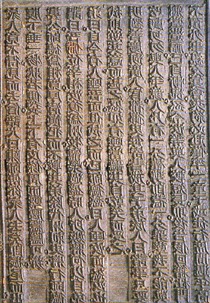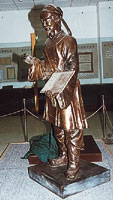| About China > Sci-Tech > Ancient > Four Inventions |
|
|
Four Great Inventions of Ancient China -- Printing
It took a lot of time and energy as well as materials to prepare for printing a book, but it worked more effectively afterwards. This technology was gradually introduced to Korea, Japan, Vietnam, and the Philippines.
Yet, Block Printing had its drawbacks -- all the boards became useless after the printing was done and a single mistake in carving could ruin the whole block. The frontispiece of the world's oldest surviving book, the Diamond Sutra printed in the year 868, was discovered at Dunhuang Cave, along the Silk Road. The book, in the form of a roll, is the earliest woodcut illustration in a printed book.
In the Song Dynasty (960-1279), a man named Bi Sheng carved individual characters on identical pieces of fine clay. Each piece of movable type had on it one Chinese character which was carved in relief on a small block of moistened clay. After the block had been hardened by fire, the type became hard and durable and could be used wherever required. The pieces of movable type could be glued to an iron plate and easily detached from the plate. Each piece of character could be assembled to print a page and then broken up and redistributed as needed. When the printing was finished, the pieces were put away for future use.
By the year1000, paged books in the modern style had replaced scrolls. Two color printing (black and red) was seen as early as 1340.
This technology then spread to Korea, Japan, Vietnam and Europe. Later, German Johann Gutenberg invented movable type made of metal in the 1440s. Movable Type Printing developed very fast. Based on clay type, type made of wood, lead, tin and copper gradually appeared. |
||||||
All rights reserved. Reproduction of text for non-commercial purposes is permitted provided that both the source and author are acknowledged and a notifying email is sent to us. |
||||||
 |
 Block
Printing
Block
Printing
 Movable Type
Printing
Movable Type
Printing